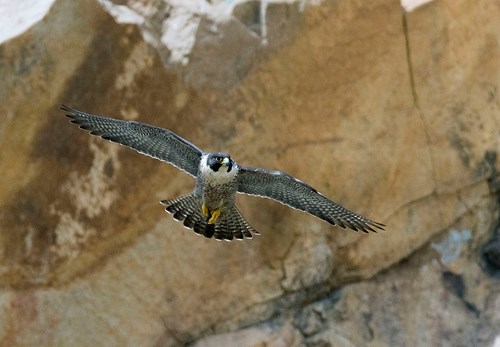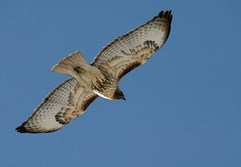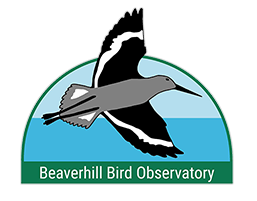Impacts of Climate Change on Birds of Prey
Tuesday, April 7, 2020A Brief History of Birds of Prey in North America
In the twentieth century, many populations of birds of prey declined sharply. Species including the Bald Eagle and Peregrine Falcon, declined to the brink of near extinction due to habitat destruction, habitat degradation, illegal hunting, and most importantly, contamination of food due to a pesticide called DDT. Let’s look at the story of Peregrine Falcon to fully understand the impact of this pesticide.
In the 1940s and 1950s, DDT was used heavily on crops in the agriculture industry to kill insect pests. However, what we didn’t know at the time is that DDT is a bioaccumulant and it accumulates in the bodies of the animals it eats. So whenever the Peregrine Falcons fed on birds that ate contaminated seeds and/or insects, they would increase the concentration of DDT in their bodies. Eventually the levels of DDT became so high and concentrated in our falcons’ bodies that it impacted the biology of the birds, reducing the ability of females to produce calcium in eggshells. This resulted in thinner, weaker eggshells, eventually causing the eggshells to crack and break during incubation. These continual nest failures caused the population of Peregrine Falcons to drastically decline by 90%, to the point where there was only one pair left in southern Canada and less than 324 pairs left in the entire United States. However, in the 1970s, things turned around for this species. Scientific findings led to a full ban on the use of DDT, and many captive breeding programs aided the falcons to successfully reproduce and young were reintroduced back into the wild. As a result, Peregrine Falcons are no longer an endangered species and currently have a population of over 2,100 individuals in Canada! Similarly, Bald Eagle populations decline due to DDT resulting in only 417 nesting pairs remaining in the United States by 1963, before conservation efforts led to a recovery. Yet as the climate change crisis continues, Peregrine Falcons, Bald Eagle, and other birds of prey, will start facing new challenges in order to survive.
Impact of Climate Change on Birds of Prey
The impacts of climate change on birds varies from species to species. Let’s look at the Bald Eagle to begin with. One of the biggest concerns of climate change’s impact for this species relates to its food supply. During the winter months, Salmon are a major food source for Bald Eagles living on the west coast. Salmon fry first migrate from their birth stream to the Pacific Ocean but eventually return back to that same stream to spawn, where they then die. These salmon carcasses become food for the wintering Bald Eagles. With the warming temperatures caused by climate change however, researchers predict that salmon carcass decomposition will accelerate, meaning there will be a reduction in the winter food supply for Bald Eagles. Further, snow peaks are also melting faster due to climate change which is increasing the water level and turbulence in these streams. This in turn is resulting in less Salmon carcasses available on the stream banks, leading to a greater decline in the food supply for Bald Eagles.
Climate change has also shifted the spring and fall migration times for many birds of prey. For species like Bald Eagles, Rough-legged Hawks, and Golden Eagles, the interval between spring and fall migration has lengthened by as much as 30 days since the early 1970s, i.e., these species are spending up to 30 days longer in their summer grounds. Changing migration timing poses many challenges for these birds. They may experience bad weather if they arrive too early in the spring at their summer grounds or leave too late in the fall. Earlier migration also leads to early breeding, egg laying, and chick hatching in some species, which can increase the chances of nest failure caused by food scarcity due to bad weather.
 Other species are going under even more dramatic changes, such as the Red-tailed Hawks. Research show that an increasing number of Red-tailed Hawks either do no migrate at all, or migrate much shorter distances, and are wintering further north. Between 1975 and 2011, the winter range of Red-tailed Hawks moved northward at a rate of 6 km per year in western North America. This dramatic shift may impact the ecological balance, such as predator-prey relationship, in their traditional wintering grounds. It may lead to food shortages in their summer territories while a rampant overabundance of rodents and other mammals occurs in their traditional winter territories.
Other species are going under even more dramatic changes, such as the Red-tailed Hawks. Research show that an increasing number of Red-tailed Hawks either do no migrate at all, or migrate much shorter distances, and are wintering further north. Between 1975 and 2011, the winter range of Red-tailed Hawks moved northward at a rate of 6 km per year in western North America. This dramatic shift may impact the ecological balance, such as predator-prey relationship, in their traditional wintering grounds. It may lead to food shortages in their summer territories while a rampant overabundance of rodents and other mammals occurs in their traditional winter territories.
 Climate change has also increased the frequency of heavy rainfall in the Arctic over the last three decades, which is affecting Arctic Peregrine Falcon nestlings. Nestlings are extremely vulnerable to rain, especially when their parents cannot protect them such as when they are hunting. During heavy rain, a nestling’s downy feathers may get wet, resulting in them losing that vital layer of insolation, becoming hypothermic and often dying. One study found that 1/3 of Peregrine Falcon nestlings died due to heavy rainfall. Therefore, as the climate change crisis worsens, it will jeopardize Arctic Peregrine Falcon populations, as well as populations of Bald Eagles, Rough-legged Hawks, and other birds of prey.
Climate change has also increased the frequency of heavy rainfall in the Arctic over the last three decades, which is affecting Arctic Peregrine Falcon nestlings. Nestlings are extremely vulnerable to rain, especially when their parents cannot protect them such as when they are hunting. During heavy rain, a nestling’s downy feathers may get wet, resulting in them losing that vital layer of insolation, becoming hypothermic and often dying. One study found that 1/3 of Peregrine Falcon nestlings died due to heavy rainfall. Therefore, as the climate change crisis worsens, it will jeopardize Arctic Peregrine Falcon populations, as well as populations of Bald Eagles, Rough-legged Hawks, and other birds of prey.
What Can We Do?
To reduce climate change, you can reduce your carbon footprint by setting your fridge and freezer to the optimal temperature! Samsung recommends setting your fridge temperature at +3˚C and your freezer temperature at -18˚C. By setting these appliances to their optimal temperature, this means you are using less power, thereby reducing your electricity consumption and your carbon footprint. As well, unplugging other kitchen appliances when not in use, such as your; kettle, toaster, blender, coffee maker, etc, will also help reduce your energy use. These small changes will help you reduce your carbon footprint, while also saving money on your electricity bill!
Other helpful tips on how to reduce your carbon footprint to help reduce climate change can be found on our website here.
Picture Credit:
Andy Reago & Chrissy McClarren, accessed on April 2, 2020, retrieved from https://commons.wikimedia.org/wiki/File:Bald_Eagle_(31446429584).jpg
Natl1, accessed on April 7th, 2020. Retrieved from https://commons.wikimedia.org/wiki/File:Red-tailed_Hawk27.jpg
Metropolitan Transportation Authority of the State of New York (MTA), accessed on April 7th, 2020. Retrieved from https://commons.wikimedia.org/wiki/File:Verrazano_Bridge_Falcons_(17731107354).jpg
Peregrine Falcon in flight across Morro Rock in Morro Bay, California. By Kevin Cole, Pacific Coast USA. 29 June 2012. https://commons.wikimedia.org/wiki/File:Falco_peregrinus_Morro_Rock.jpg
Additional Readings:
Harvey, Chris J., Pamela E. Moriarty, and Eric P. Salathé Jr. "Modeling climate change impacts on overwintering bald eagles." Ecology and evolution 2, no. 3 (2012): 501-514.
Buskirk, Josh Van. "Changes in the annual cycle of North American raptors associated with recent shifts in migration timing." The Auk 129, no. 4 (2012): 691-698.
Paprocki, Neil, Dave Oleyar, David Brandes, Laurie Goodrich, Tara Crewe, and Stephen W. Hoffman. "Combining migration and wintering counts to enhance understanding of population change in a generalist raptor species, the North American Red-tailed Hawk." The Condor: Ornithological Applications 119, no. 1 (2017): 98-107.
Zaifman, Jay, Daoyang Shan, Ahmet Ay, and Ana Gabriela Jimenez. "Shifts in bird migration timing in North American long-distance and short-distance migrants are associated with climate change." International Journal of Zoology 2017 (2017).
Brown, Bryan T., Lawrence E. Stevens, and Teresa A. Yates. "Influences of fluctuating river flows on Bald Eagle foraging behavior." The Condor 100, no. 4 (1998): 745-748.
Anctil, Alexandre, Alastair Franke, and Joël Bêty. "Heavy rainfall increases nestling mortality of an arctic top predator: experimental evidence and long-term trend in peregrine falcons." Oecologia 174, no. 3 (2014): 1033-1043.
Paprocki, Neil, Julie A. Heath, and Stephen J. Novak. "Regional distribution shifts help explain local changes in wintering raptor abundance: implications for interpreting population trends." PLoS One 9, no. 1 (2014).
https://www.fws.gov/midwest/eagle/history/index.html
http://nabci.net/wp-content/uploads/39-184-Bird-Survey-Corrections_EN_web.pdf
https://www.biologicaldiversity.org/campaigns/esa_works/profile_pages/AmericanPerigrineFalcon.html
https://www.fws.gov/midwest/eagle/history/index.html
https://www.biologicaldiversity.org/campaigns/esa_works/profile_pages/AmericanPerigrineFalcon.html
https://www.cbc.ca/news/canada/edmonton/peregrine-falcon-threatened-species-1.4433052
https://www.allaboutbirds.org/guide/Bald_Eagle/maps-range
https://www.yaleclimateconnections.org/2018/07/how-climate-change-could-hurt-bald-eagles/
https://www.nps.gov/articles/climate-change-and-trends-in-bald-eagle-winter-habitat-use.htm
https://www.usgs.gov/faqs/why-do-salmon-change-color-and-die-after-they-spawn
https://www.cbc.ca/news/canada/north/arctic-rain-threatens-baby-peregrine-falcons-1.2450721
Blog Posts
- What is Climate Change
- Drought: What Can We Do?
- Migration and Climate Change; a Complicated Relationship (Part 1)
- Migration and Climate Change; a Complicated Relationship (Part 2)
- Climate Change and Birds’ Resources
- Ladder to Extinction
- Arctic Warming and Ecosystem Impacts
- Climate Change Connection to Mountain Pine Beetle
- Tackling Climate Change Denialism
- Impact of Climate Change on Bluebirds
- An Introduction to Climate Change
- Great Decline of Aerial Insectivores
- Role of Oceans in Fighting Climate Change
- Role Of Forests In Fighting Climate Change
- Impact of Climate Change on Shorebirds
- Impact of Hurricanes and Climate Change on Birds
- An Introduction to Climate Change.
- Impact of Forest Fires, and Climate Change on the Nature
- Impacts of Climate Change on Owls
- Impacts of Climate Change on Birds of Prey
- Whitebark Pine and Clark's Nutcracker
- COVID 19 & The Environment
- Impact of Global Warming on Bird Anatomy and Colour Polymorphism
- Climate Change & West Nile Virus
- All Posts

